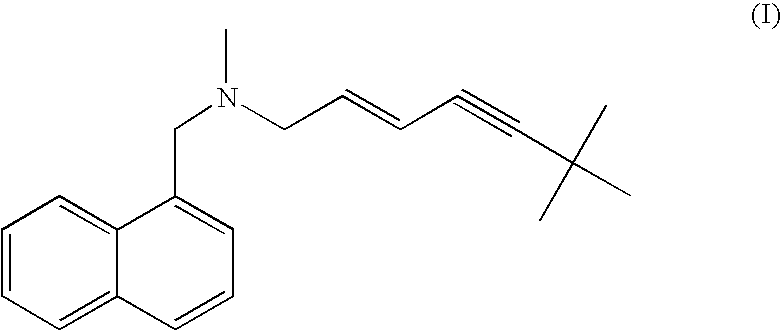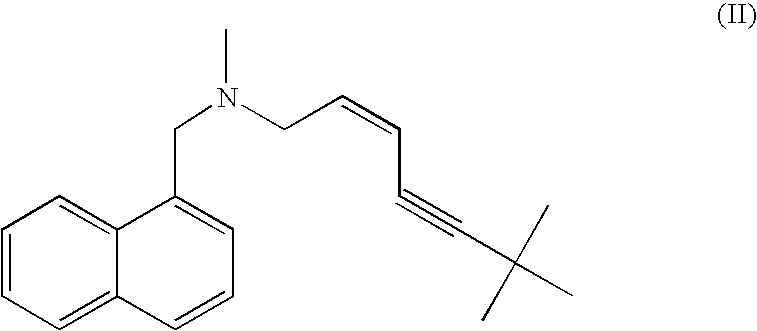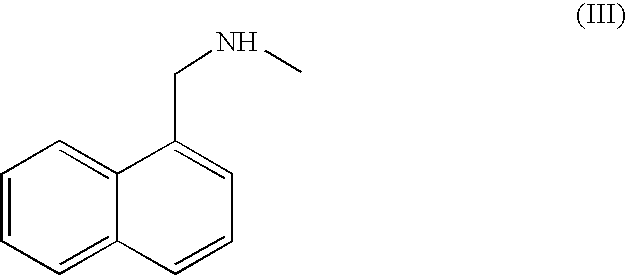Process for the preparation of terbinafine and salts thereof
a technology of terbinafine and salt, applied in the field of synthetic chemistry, can solve the problems of inefficiency of process teaching, ineffective overall yield, and disadvantage of process teaching, and achieve the effect of improving the overall yield and reducing the cost of production
- Summary
- Abstract
- Description
- Claims
- Application Information
AI Technical Summary
Benefits of technology
Problems solved by technology
Method used
Image
Examples
example 1
Preparation of 1-chloro-6,6-dimethyl-2-heptene-4-yne
[0127] 6,6-dimethylhept-1-en-4-yn-3-ol (V) was prepared according to the procedure described U.S. Pat. No. 6,570,044.
[0128] 72.5 ml of a 36% aqueous HCl solution and 8 grams (0.058 mole) phosphorous trichloride were combined with gentle mechanical stirring in a three-necked 250 ml reactor. The temperature of the mixture rose to 40° C. Mixing was continued at 40° C. until a clear solution was obtained. The reaction mixture was cooled to 10° C. and a solution of 20 grams (0.145 mole) 6,6-dimethylhept-1-en-4-yn-3-ol (V) in 23 ml of ethanol was added. With continuous mixing, the mixture was gradually warmed up to and maintained at room temperature for a period of two hours.
[0129] 30 ml hexane and 30 ml ice-cold water were added and the two phases separated. The organic phase was washed with a 10% sodium bicarbonate solution (3×30 ml) followed by multiple water washes to neutrality. The organic phase was dried with magnesium sulfate ...
example 2
Preparation of Terbinafine HCl Using Aqueous HCl
[0133] 124.8 grams (0.601 mole) N-methyl-1-naphthylmethyl amine (III) HCl followed by 120 grams (1.1 mole) sodium carbonate were added to 720 ml tap water in a three-necked reactor with stirring at 300-350 rpm. The reaction mixture was heated to 77-83° C. 93.6 grams (0.598 mole) 1-chloro-6,6-dimethyl-2-heptene-4-yne (IVb), obtained as described above were added over a four-hour period. After 4 additional hours at 80° C., stirring was ceased, leading to an immediate appearance of two phases. The lower aqueous phase was removed from the reactor and washed with toluene (2×100 ml). The two toluene washes and an additional 720 ml toluene were added to the reactor. The toluene solution was allowed to cool to room temperature.
[0134] 66 ml of a 32% aqueous HCl solution were added to the toluene solution so as to acidify the solution to a pH of about 0.5-1.5 as measured using a Gel Pressure Electrode, produced by Mettler-Toledo International....
example 4
Preparation of Purified Terbinafine HCl
[0137] 100 grams of the product from Example 2, containing the hydrochloride salt of Terbinafine (I) and the cis isomer (II) was dissolved in 500 ml isopropanol at reflux temperature. The solution was cooled to 25° C. and the mixture was stirred for 4 hours. The resulting suspension was filtered using Whatman No. 1 filter paper and the cake washed with 60 ml isopropyl alcohol. After 4 hours drying at 50° C., 80 grams of Terbinafine hydrochloride were obtained, having a purity greater than 99.5%, as determined by HPLC analysis as follows:
[0138] A mobile phase comprising 200 ml THF, 400 ml acetonitrile and 400 ml of an aqueous buffer solution (6 g sodium dihydrogen phosphate dihydrate in 1 liter of water and adjusted to pH 6.5 using 1.0 N NaOH) was prepared. 30 mg of product was dissolved in 100.0 ml of the mobile phase.
[0139] A 10 μl sample of the thus prepared product-containing solution into an HPLC using a UV detector at 220 nm on a 250×4....
PUM
| Property | Measurement | Unit |
|---|---|---|
| Temperature | aaaaa | aaaaa |
| Temperature | aaaaa | aaaaa |
| Temperature | aaaaa | aaaaa |
Abstract
Description
Claims
Application Information
 Login to View More
Login to View More - R&D
- Intellectual Property
- Life Sciences
- Materials
- Tech Scout
- Unparalleled Data Quality
- Higher Quality Content
- 60% Fewer Hallucinations
Browse by: Latest US Patents, China's latest patents, Technical Efficacy Thesaurus, Application Domain, Technology Topic, Popular Technical Reports.
© 2025 PatSnap. All rights reserved.Legal|Privacy policy|Modern Slavery Act Transparency Statement|Sitemap|About US| Contact US: help@patsnap.com



